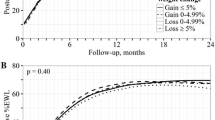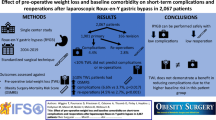Abstract
Background
This study assessed whether preoperative weight loss resulted in favorable outcomes after open Roux-en Y gastric bypass (RYGB).
Methods
A retrospective review of all patients who underwent RYGB at the DVAMC was undertaken. Patients were divided into: patients who did not lose weight within 3 months preoperatively (n = 25) and group II, those who did (n = 15).
Results
Both groups had similar demographics, body mass index, comorbid conditions, and American Society of Anesthesiology class. Group II lost 28.2 ± 6.5 lbs (8.3% of body weight) within 3 months before RYGB. Operative time was longer in group I compared to group II (180.0 ± 0.0 vs 161.0 ± 0.0 min; p = 0.05). Both groups had the same rate of postoperative complications and the same long-term weight loss at a 2-year follow-up (n = 6 both groups).
Conclusions
An 8% reduction of body weight is associated with a decrease in operative time. These preliminary data suggest that preoperative weight loss results in a technically less challenging operation in the super-obese patient.


Similar content being viewed by others
References
Wang A, Kinsinger LS, Kahwati LC, et al. Obesity and weight control practices in 2000 among veterans using VA facilities. Obes Res 2005;13:1405–11.
Huerta S, Kohan D, Siddiqui A, et al. Assessment of comorbid conditions in veteran patients after Roux-en-Y gastric bypass. Am J Surg 2007;194:48–52.
Alami RS, Morton JM, Sanchez BR, et al. Laparoscopic Roux-en-Y gastric bypass at a Veterans Affairs and high-volume academic facilities: a comparison of institutional outcomes. Am J Surg 2005;190:821–5.
Gallagher SF, Banasiak M, Gonzalvo JP, et al. The impact of bariatric surgery on the Veterans Administration healthcare system: a cost analysis. Obes Surg 2003;13:245–8.
Safadi BY, Kieran JA, Hall RG, et al. Introducing laparoscopic Roux-en-Y gastric bypass at a Veterans Affairs medical facility. Am J Surg 2004;188:606–10.
Podnos YD, Jimenez JC, Wilson SE, et al. Complications after laparoscopic gastric bypass: a review of 3464 cases. Arch Surg 2003;138:957–61.
Maggard MA, Shugarman LR, Suttorp M, et al. Meta-analysis: surgical treatment of obesity. Ann Intern Med 2005;142:547–59.
Livingston EH, Huerta S, Arthur D, et al. Male gender is a predictor of morbidity and age a predictor of mortality for patients undergoing gastric bypass surgery. Ann Surg 2002;236:576–82.
Arteaga JR, Huerta S, Basa NR, et al. Interval jejunoileal bypass reduces the morbidity and mortality of Roux-en-Y gastric bypass in the super-obese. Am Surg 2003;69:873–8.
Nguyen NT, Longoria M, Gelfand DV, et al. Staged laparoscopic Roux-en-Y: a novel two-stage bariatric operation as an alternative in the super-obese with massively enlarged liver. Obes Surg 2005;15:1077–81.
Huerta S, Li Z, Livingston EH. Outcome of portal injuries following bariatric operations. Obes Surg 2006;16:105–9.
National Heart, Lung, and Blood Institute. Clinical Guidelines on the identification, evaluation and treatment of overweight and obesity in adults: the evidence report. Washington, DC: National Heart, Lung and Blood Institute (ref type: generic); 1998.
Knowler WC, Barrett-Connor E, Fowler SE, et al. Reduction in the incidence of type 2 diabetes with lifestyle intervention or metformin. N Engl J Med 2002;346:393–403.
Alvarado R, Alami RS, Hsu G, et al. The impact of preoperative weight loss in patients undergoing laparoscopic Roux-en-Y gastric bypass. Obes Surg 2005;15:1282–6.
Alami RS, Morton JM, Schuster R, et al. Is there a benefit to preoperative weight loss in gastric bypass patients? A prospective randomized trial. Surg Obes Relat Dis 2007;3:141–5.
Lujan JA, Frutos MD, Hernandez Q, et al. Laparoscopic versus open gastric bypass in the treatment of morbid obesity: a randomized prospective study. Ann Surg 2004;239:433–7.
Nguyen NT, Goldman C, Rosenquist CJ, et al. Laparoscopic versus open gastric bypass: a randomized study of outcomes, quality of life, and costs. Ann Surg 2001;234:279–89.
Westling A, Gustavsson S. Laparoscopic vs open Roux-en-Y gastric bypass: a prospective, randomized trial. Obes Surg 2001;11:284–92.
Huerta S, Heber D, Sawicki MP, et al. Reduced length of stay by implementation of a clinical pathway for bariatric surgery in an academic health care center. Am Surg 2001;67:1128–35.
Author information
Authors and Affiliations
Corresponding author
Rights and permissions
About this article
Cite this article
Huerta, S., Dredar, S., Hayden, E. et al. Preoperative Weight Loss Decreases the Operative Time of Gastric Bypass at a Veterans Administration Hospital. OBES SURG 18, 508–512 (2008). https://doi.org/10.1007/s11695-007-9334-5
Received:
Accepted:
Published:
Issue Date:
DOI: https://doi.org/10.1007/s11695-007-9334-5




